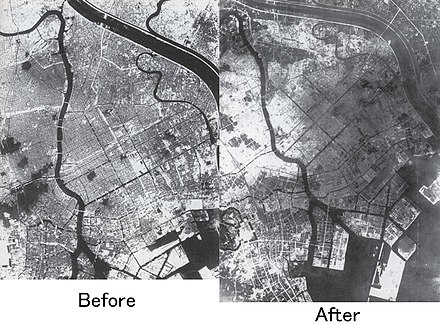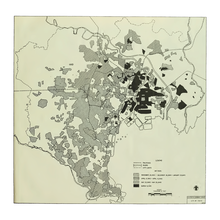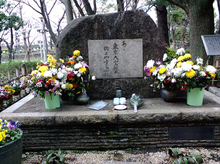User:Wikidgood/sandbox2
The bombing of Tokyo, frequently referred to as the "firebombing", was conducted by the United States Army Air Forces took place during the Pacific campaigns of World War II. The U.S. mounted a small-scale raid on Tokyo in April 1942, with large morale effects. Strategic bombing and urban area bombing began in 1944 after the long-range B-29 Super Fortress bomber entered service, first employed from China and thereafter the Mariana Islands. B-29 raids from those islands commenced on November 17, 1944 and lasted until August 15, 1945, the day Japan capitulated.[1] The air raid of 9-10 March 1945 was one of the most destructive bombing raids in history.
Doolittle Raid

The first raid on Tokyo was the Doolittle Raid of 18 April 1942, when sixteen B-25 Mitchells were launched from USS Hornet to attack targets including Yokohama and Tokyo and then fly on to airfields in China. The raid was the retaliation against the Japanese attack on Pearl Harbor. The raid did no damage to Japan's war capability but was a significant propaganda victory for the United States.[2] Launched prematurely, none of the attacking aircraft reached the designated airfields, either crashing or ditching (except for one aircraft which landed in the Soviet Union, where the crew was officially interned and secretly repatriated). Two crews were captured by the Japanese in occupied China.
B-29 raids



The key development for the bombing of Japan was the B-29 bomber plane, which had an operational range of 3,250 nautical miles (6,019 km); almost 90% of the bombs dropped on the home islands of Japan were delivered by this type of bomber. Once Allied ground forces had captured islands sufficiently close to Japan, airfields were built on those islands (particularly Saipan and Tinian) and B-29s could reach Japan for bombing missions.
The initial raids were carried out by the Twentieth Air Force operating out of mainland China in Operation Matterhorn under XX Bomber Command, but these could not reach Tokyo. Operations from the Northern Mariana Islands commenced in November 1944 after the XXI Bomber Command was activated there. The B-29s of XX Bomber Command were transferred to XXI Bomber Command in the spring of 1945 and based on Guam.[citation needed]
The first raid using low-flying B-29s carrying incendiary bombs to drop on Tokyo was in February 1945 when 174 B-29s destroyed around one square mile (3 km²) of the city.[citation needed] Changing their tactics to expand the coverage and increase the damage, 335 B-29s took off[3] to raid on the night of 9–10 March, with 279 of them[3] dropping around 1,700 tons of bombs. Fourteen B-29s were lost.[3] Approximately 16 square miles (41 km²) of the city were destroyed and some 100,000 people are estimated to have died in the resulting firestorm, more than the immediate deaths of either the Hiroshima or Nagasaki atomic bombs.[4][5] The US Strategic Bombing Survey later estimated that nearly 88,000 people died in this one raid, 41,000 were injured, and over a million residents lost their homes. The Tokyo Fire Department estimated a higher toll: 97,000 killed and 125,000 wounded. The Tokyo Metropolitan Police Department established a figure of 124,711 casualties including both killed and wounded and 286,358 buildings and homes destroyed. Richard Rhodes, historian, put deaths at over 100,000, injuries at a million and homeless residents at a million.[6] These casualty and damage figures could be low; Mark Selden wrote in Japan Focus:
The figure of roughly 100,000 deaths, provided by Japanese and American authorities, both of whom may have had reasons of their own for minimizing the death toll, seems to me arguably low in light of population density, wind conditions, and survivors' accounts. With an average of 103,000 inhabitants per square mile (396 people per hectare) and peak levels as high as 135,000 per square mile (521 people per hectare), the highest density of any industrial city in the world, and with firefighting measures ludicrously inadequate to the task, 15.8 square miles (41 km2) of Tokyo were destroyed on a night when fierce winds whipped the flames and walls of fire blocked tens of thousands fleeing for their lives. An estimated 1.5 million people lived in the burned out areas.[7]
The destruction and damage were greatest in the parts of the city to the east of the Imperial Palace.[citation needed] Over 50% of Tokyo was destroyed by the end of World War II.[citation needed]
Partial list of B-29 missions against Tokyo
- 19 February 1945: 119 B-29s hit port and urban area
- 25 February 1945: 174 B-29s dropping incendiaries destroy ~28,000 buildings
- 4 March 1945: 159 B-29s hit urban area[3]
- 10 March 1945: 334 B-29s dropping incendiaries destroy ~267,000 buildings; ~25% of city[3] (Operation Meetinghouse) killing some 100,000
- 2 April 1945: >100 B-29s bomb the Nakajima aircraft factory
- 3 April 1945: 68 B-29s bomb the Koizumi aircraft factory and urban areas in Tokyo
- 7 April 1945: 101 B-29s bomb the Nakajima aircraft factory.
- 13 April 1945: 327 B-29s bomb the arsenal area
- 15 April 1945: 109 B-29s hit urban area
- 24 May 1945: 520 B-29s bomb urban-industrial area south of the Imperial Palace
- 26 May 1945: 464 B-29s bomb urban area immediately south of the Imperial Palace
- 20 July 1945: 1 B-29 drops a Pumpkin bomb (bomb with same ballistics as the Fat Man nuclear bomb) through overcast aiming at but missing the Imperial Palace[8]
- 8 August 1945: ~60 B-29s bomb the aircraft factory and arsenal
- 10 August 1945: 70 B-29s bomb the arsenal complex
Other attacks
Additional missions against Tokyo targets were carried out by twin-engine bombers and by fighter-bombers.[9]
Aftermath


Damage to Tokyo's heavy industry was slight until firebombing destroyed much of the light industry that was used as an integral source for small machine parts and time-intensive processes. Firebombing also killed or made homeless many workers who had been taking part in war industry. Over 50% of Tokyo's industry was spread out among residential and commercial neighborhoods; firebombing cut the whole city's output in half.[10]
The Imperial Palace was surrounded by areas destroyed by firebombing. The main Palace itself (Kyūden), home of the Imperial General Headquarters, took heavy damage by fire, even though bombing it was specifically prohibited by USAAF order.
Emperor Hirohito's viewing of the destroyed areas of Tokyo in March, 1945, is said to have been the beginning of his personal involvement in the peace process, culminating in Japan's surrender five months later.[11]
After the war, Tokyo struggled to rebuild. In 1945/1946, the city received a share of the national reconstruction budget roughly proportional to its amount of bombing damage (26.6%), but in successive years Tokyo saw its share dwindle. By 1949, Tokyo was given only 10.9% of the budget; at the same time there was runaway inflation devaluing the money as Japan was spending more than it was bringing in from taxes. Occupation authorities such as Joseph Dodge stepped in and drastically cut back on Japanese government rebuilding programs, focusing instead on simply improving roads and transportation. Tokyo did not experience fast economic growth until the 1950s.[12]
See also
- United States strategic bombing of Japan
- Bombing of Kobe in World War II
- Battle of Okinawa
- Battle of Iwo Jima
- Grave of the Fireflies
- Curtis LeMay
- Unexploded ordnance
- Japanese village
Notes
- ^ Craven, Wesley Frank, and James Lea Cate, eds. The Army Air Forces in World War II, Volume Five, the Pacific: Matterhorn to Nagasaki June 1944 to August 1945. Chicago: University of Chicago Press, 1953, page 558.
- ^ Shapiro, Isaac (2009). Edokko: Growing Up a Foreigner in Wartime Japan. iUniverse. p. 115. ISBN 978-1440141249.
- ^ a b c d e Air Force Historical Studies Office. U.S. Army Air Forces in World War II: Combat Chronology. March 1945. Retrieved March 3, 2009.
- ^ Freeman Dyson. Part I: A Failure of Intelligence. Technology Review, November 1 2006, MIT
- ^ David McNeill. The night hell fell from the sky. Japan Focus, March 10 2005.
- ^ Rhodes, Richard. "The Making of the Atomic Bomb". p 599. Simon & Schuster Paperbacks (1984) ISBN 0-684-81378-5.
- ^ Mark Selden. A Forgotten Holocaust: US Bombing Strategy, the Destruction of Japanese Cities and the American Way of War from the Pacific War to Iraq. Japan Focus, May 2 2007.
- ^ Norman Polmar. The Enola Gay: The B-29 That Dropped the Atomic Bomb on Hiroshima, pp. 24. Potomac Books (2004) ISBN 1-57-488836-6.
- ^ Air Force Historical Studies Office. U.S. Army Air Forces in World War II: Combat Chronology 1941–1945.
- ^ United States Strategic Bombing Survey, Summary Report (Pacific War), p. 18.
- ^ Bradley, F. J. No Strategic Targets Left. "Contribution of Major Fire Raids Toward Ending WWII" p. 38. Turner Publishing Company, limited edition. ISBN 1-56-311483-6.
- ^ Andre Sorensen. The Making of Urban Japan: Cities and Planning from Edo to the Twenty First Century RoutledgeCurzon, 2004. ISBN 0-41-535422-6.
Further information
Books
- Caidin, Martin (1960). A Torch to the Enemy: The Fire Raid on Tokyo. Balantine Books. D767.25.T6 C35.
- Coffey, Thomas M. (1987). Iron Eagle: The Turbulent Life of General Curtis LeMay. Random House Value Publishing. ISBN 0-517-55188-8.
- Crane, Conrad C. (1994). The cigar that brought the fire wind: Curtis LeMay and the strategic bombing of Japan. JGSDF-U.S. Army Military History Exchange. ASIN B0006PGEIQ.
- Frank, Richard B. (2001). Downfall: The End of the Imperial Japanese Empire. Penguin. ISBN 0141001461.
- Grayling, A. C. (2007). Among the Dead Cities: The History and Moral Legacy of the WWII Bombing of Civilians in Germany and Japan. New York: Walker Publishing Company Inc. ISBN 978-0-8027-1565-4.
- Greer, Ron (2005). Fire from the Sky: A Diary Over Japan. Jacksonville, Arkansas, U.S.A.: Greer Publishing. ISBN 0-9768712-0-3.
- Guillian, Robert (1982). I Saw Tokyo Burning: An Eyewitness Narrative from Pearl Harbor to Hiroshima. Jove Pubns. ISBN 0-86721-223-3.
- Hoyt, Edwin P. (2000). Inferno: The Fire Bombing of Japan, March 9 – August 15, 1945. Madison Books. ISBN 1568331495.
- Jablonski, Edward (1971). "Air War Against Japan". Airwar Outraged Skies/Wings of Fire. An Illustrated history of Air power in the Second World War. Doubleday. ASIN B000NGPMSQ.
- Lemay, Curtis E. (1988). Superfortress: The Story of the B-29 and American Air Power. McGraw-Hill Companies. ISBN 0-07-037164-4.
{{cite book}}: Unknown parameter|coauthors=ignored (|author=suggested) (help) - McGowen, Tom (2001). Air Raid!: The Bombing Campaign. Brookfield, Connecticut, U.S.A.: Twenty-First Century Books. ISBN 0-7613-1810-0.
- Shannon, Donald H. (1976). United States air strategy and doctrine as employed in the strategic bombing of Japan. U.S. Air University, Air War College. ASIN B0006WCQ86.
- Smith, Jim (2002). The Last Mission: The Secret History of World War II's Final Battle. Broadway. ISBN 0767907787.
{{cite book}}: Unknown parameter|coauthors=ignored (|author=suggested) (help) - Tillman, Barrett (2010). Whirlwind: The Air War Against Japan, 1942-1945. Simon & Schuster. ISBN 978-1416584407.
- Werrell, Kenneth P. (1998). Blankets of Fire. Smithsonian. ISBN 1560988711.
Web
- 67 Japanese cities firebombed in World War II.
- B29 Air Raid on Japanese Cities, with photo gallery.
- Army Air Forces in World War II.
- The Center of the Tokyo Raid and War Damages / Introduction.
- Barrell, Tony (1997). "Tokyo's Burning". ABC Online. Australian Broadcasting Corporation. Retrieved 2006-11-03. Transcript of a radio documentary/commentary on the Tokyo firebombing with excerpts from interviews with participants and witnesses.
- Craven, Wesley Frank. "Vol. V: The Pacific: Matterhorn to Nagasaki, June 1944 to August 1945". The Army Air Forces in World War II. U.S. Office of Air Force History. Retrieved December 12, 2006.
{{cite web}}: Unknown parameter|coauthors=ignored (|author=suggested) (help) - Hansell, Jr., Haywood S. (1986). "The Strategic Air War Against Germany and Japan: A Memoir". Project Warrior Studies. U.S. Office of Air Force History. Retrieved December 12, 2006.